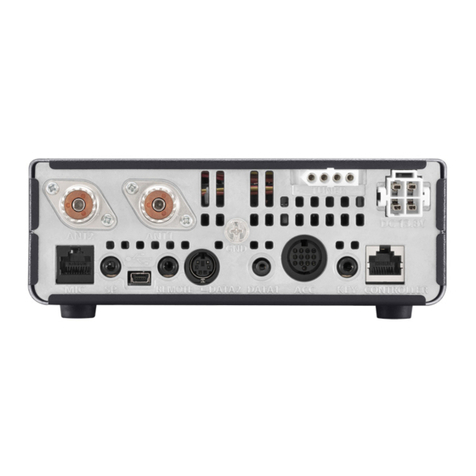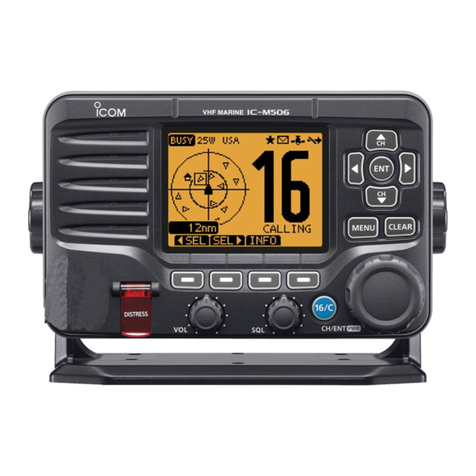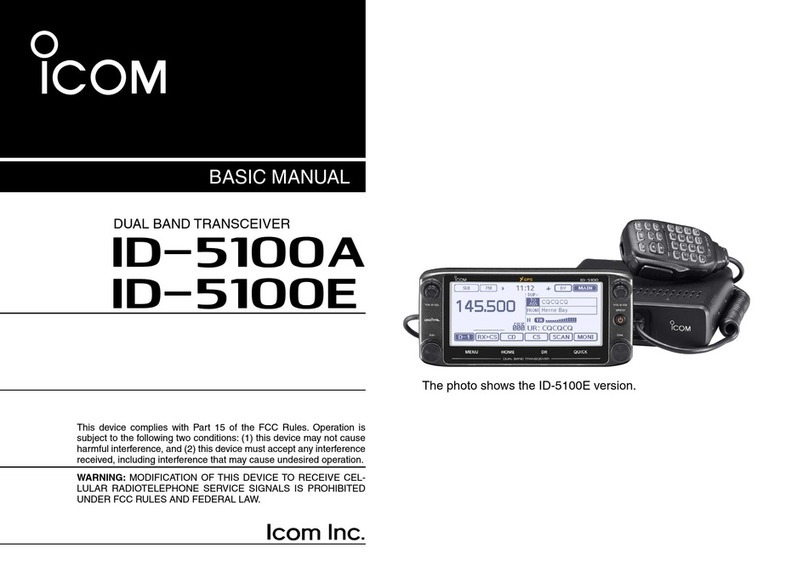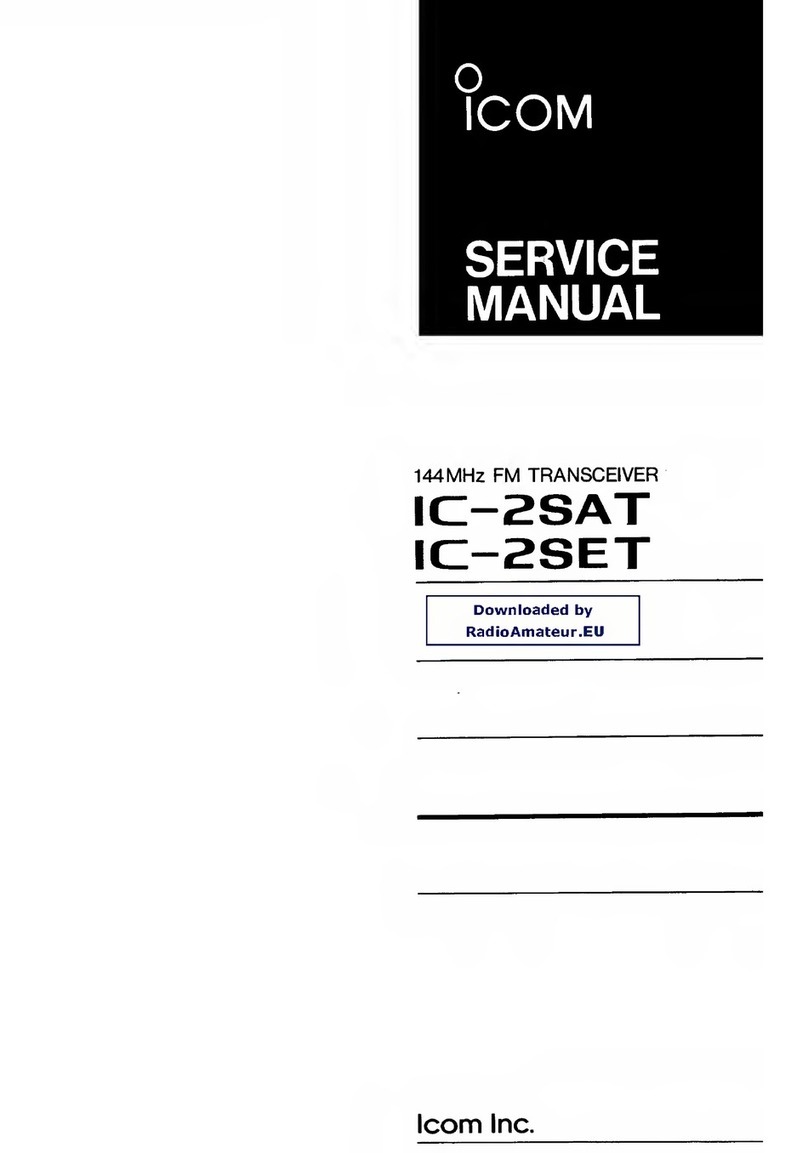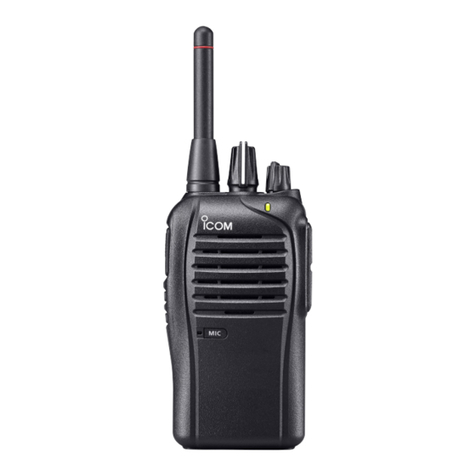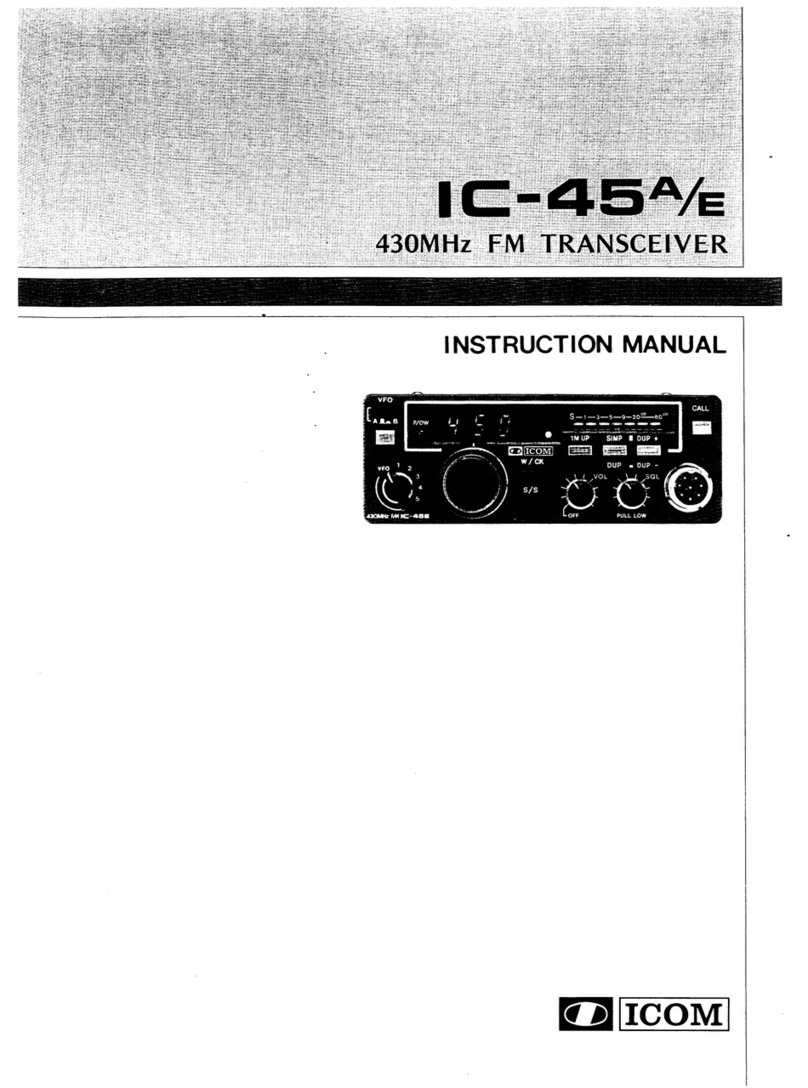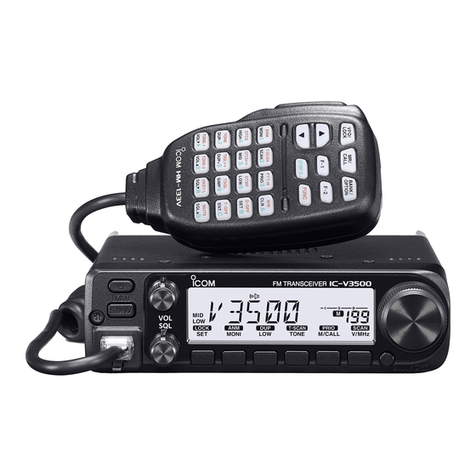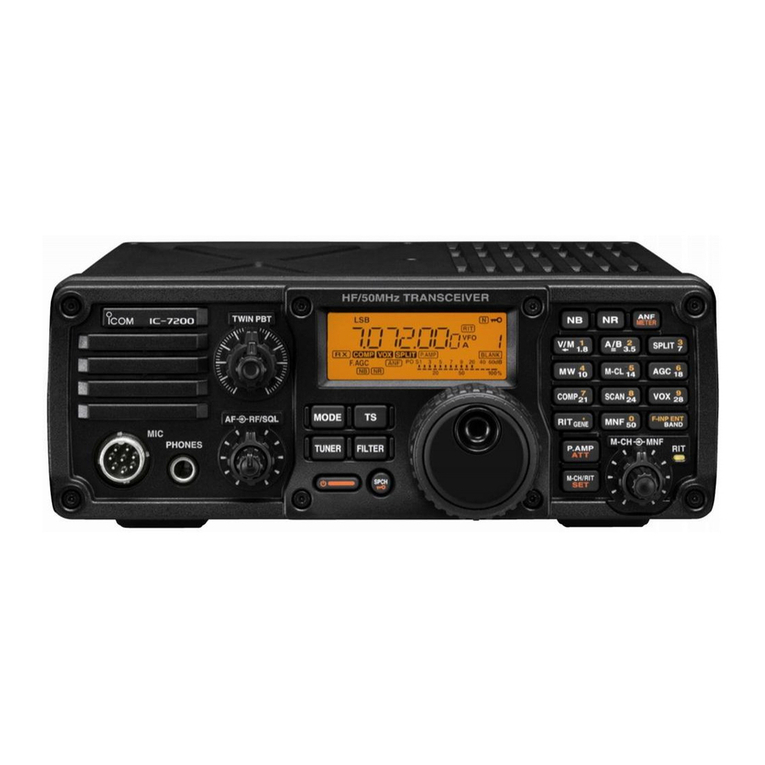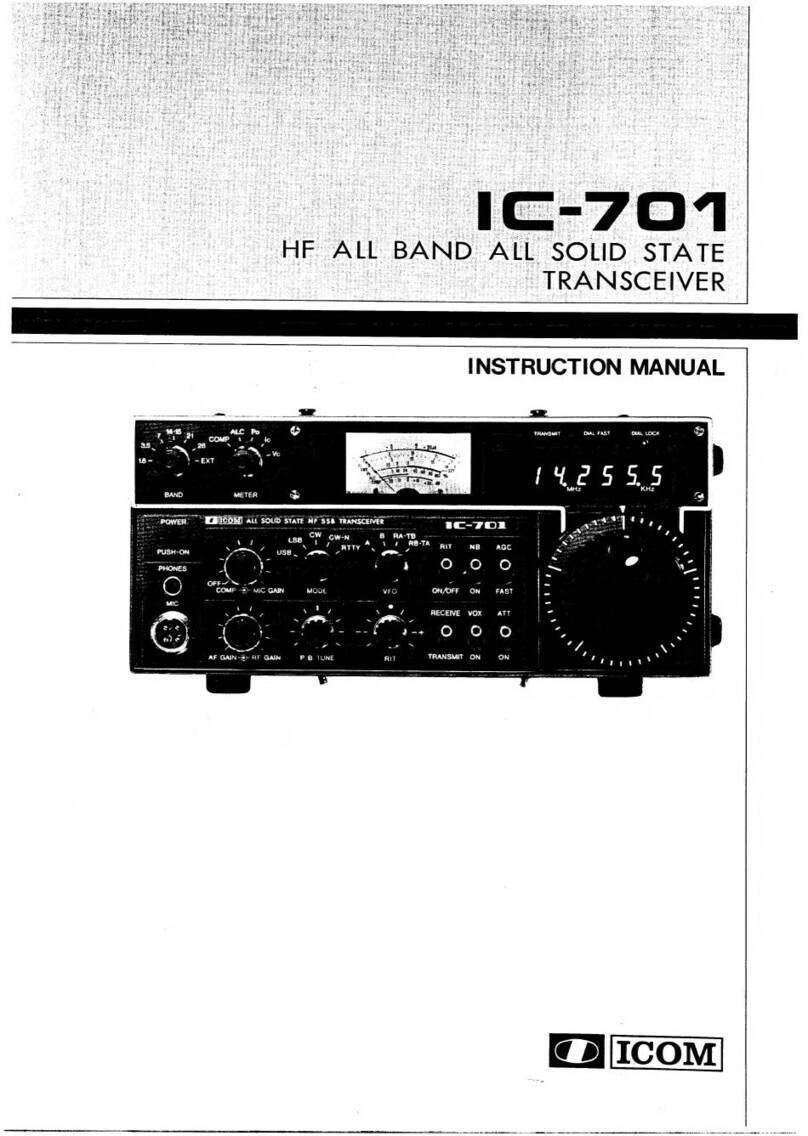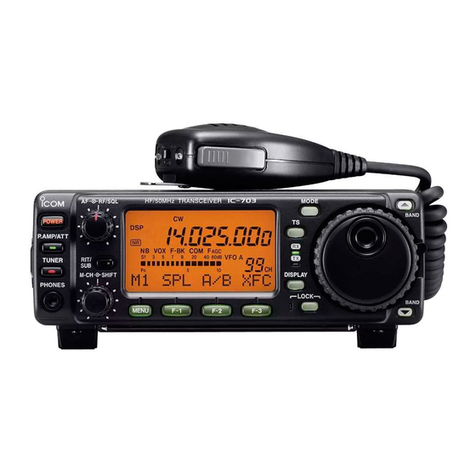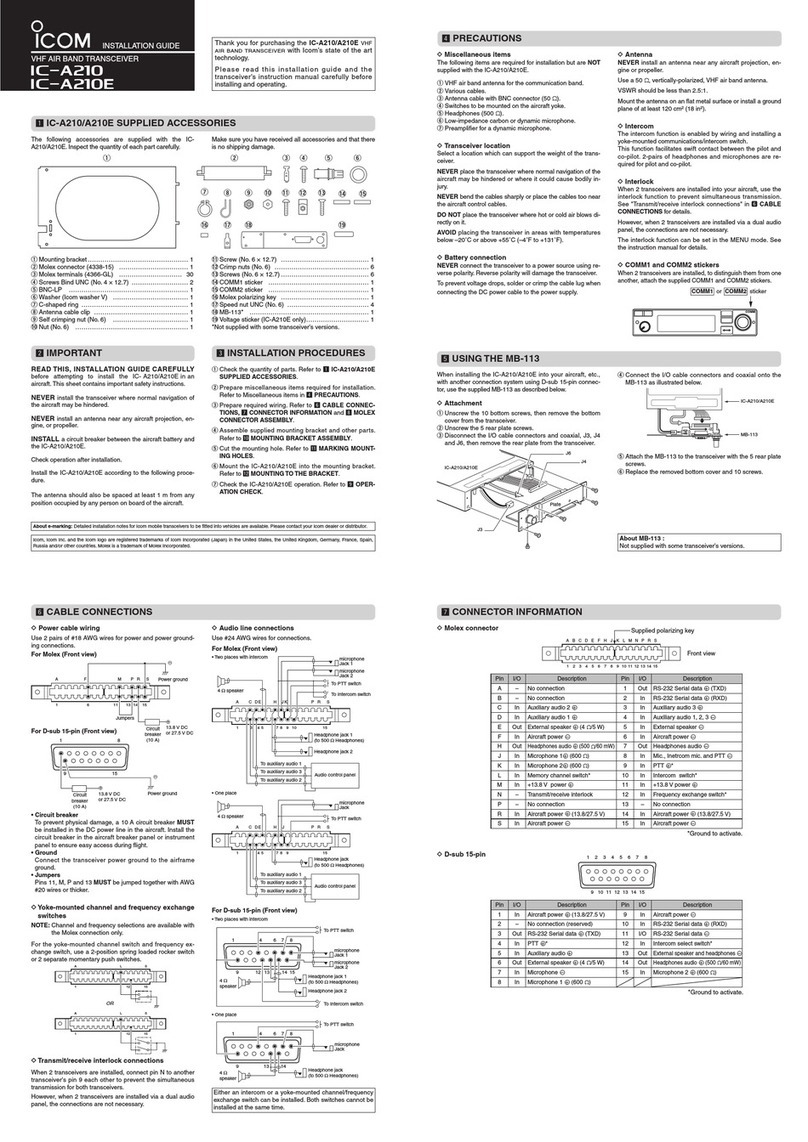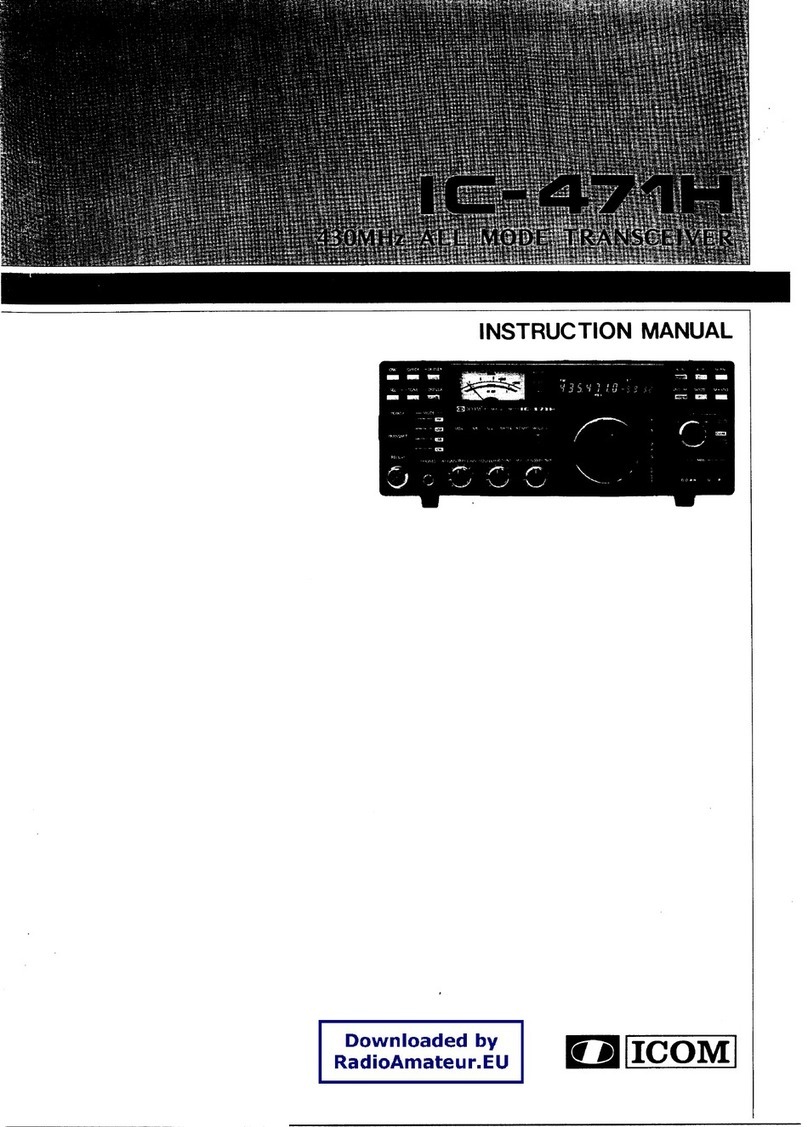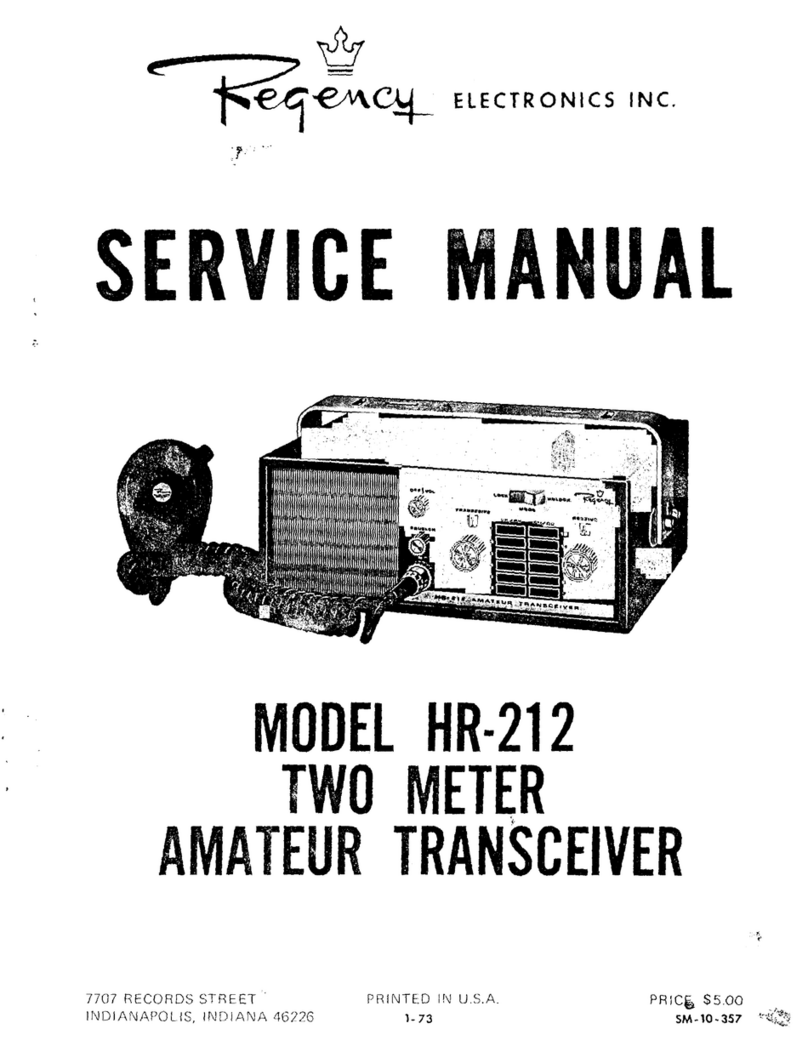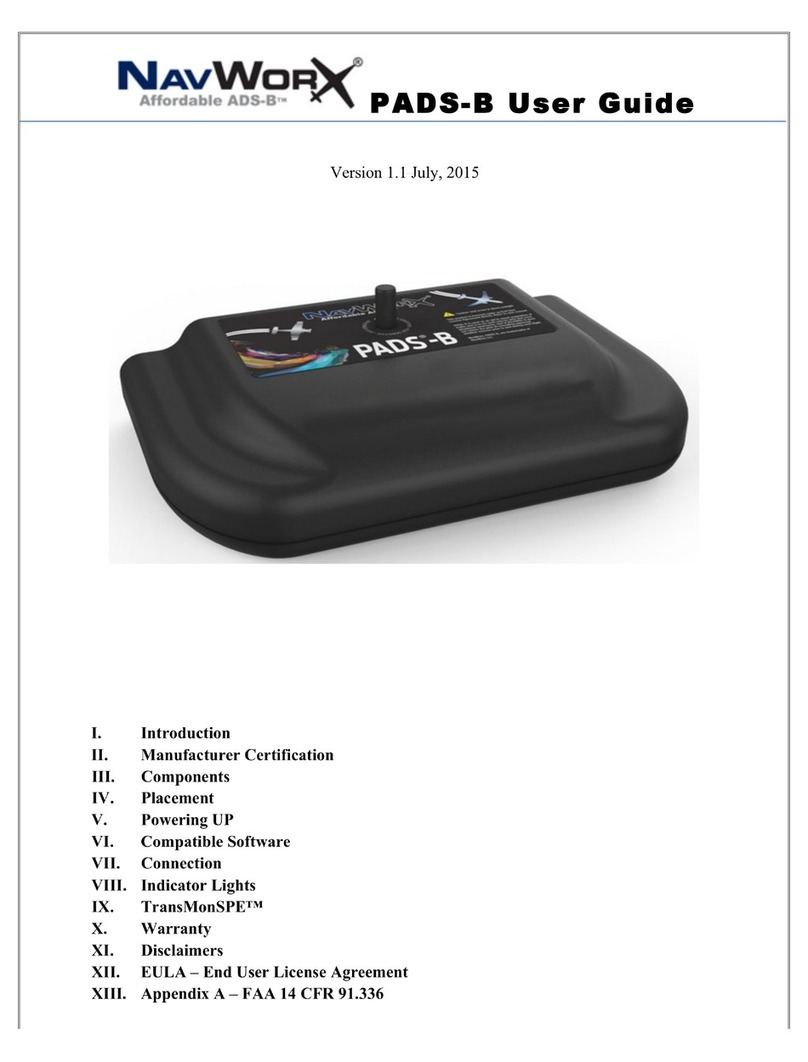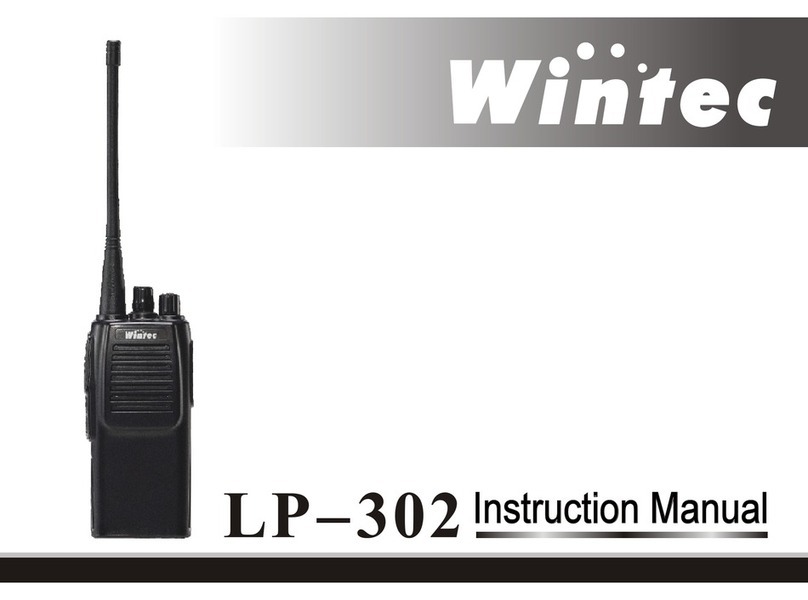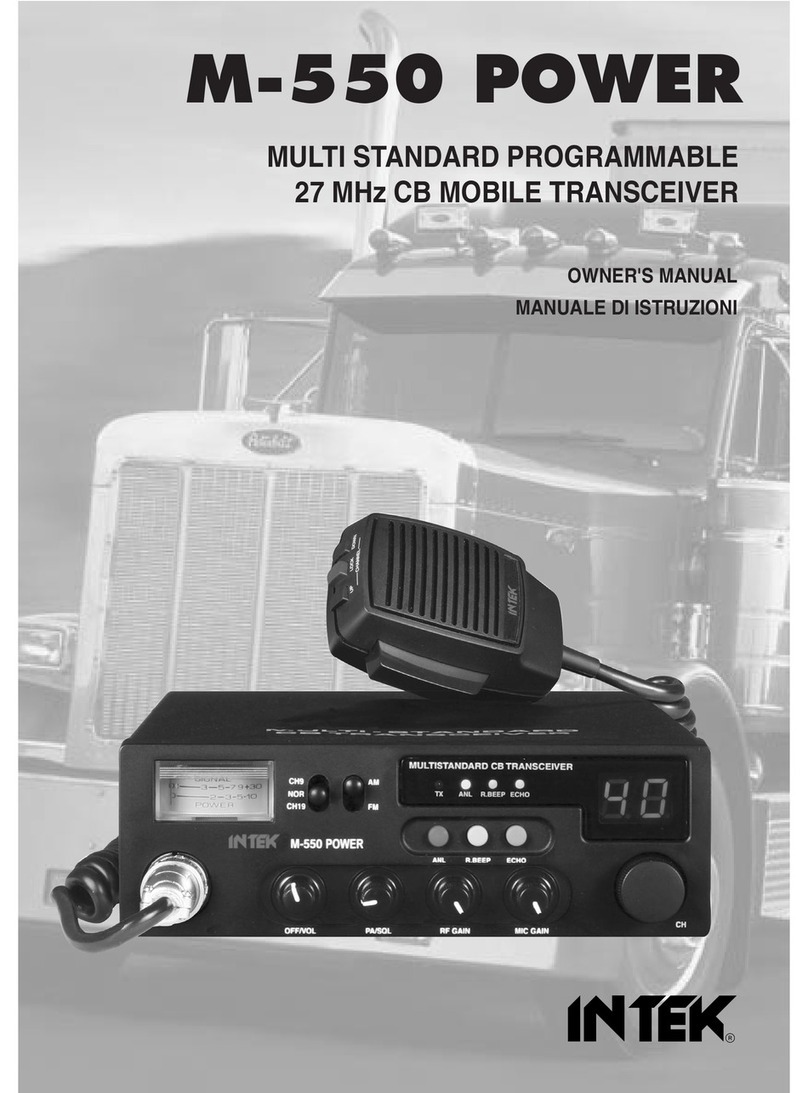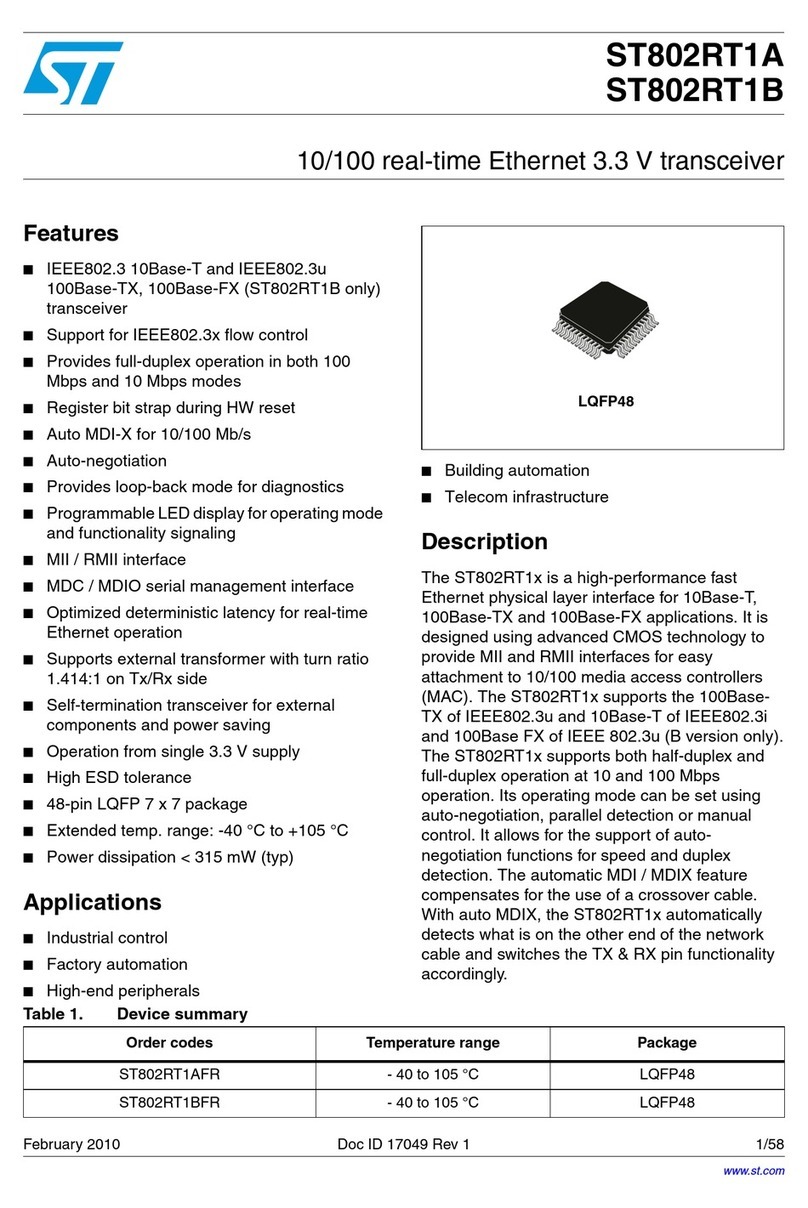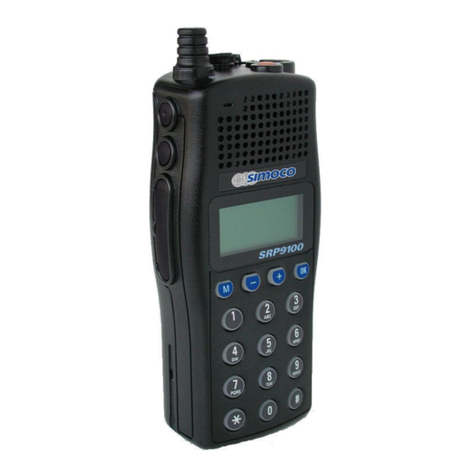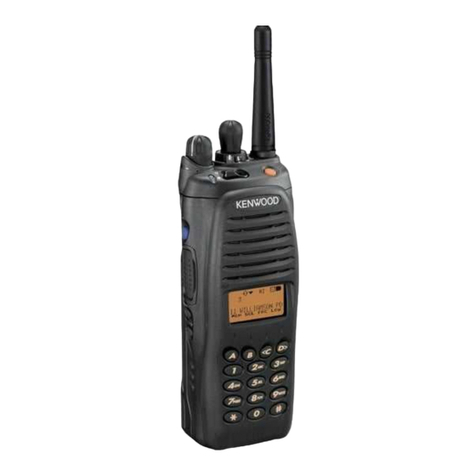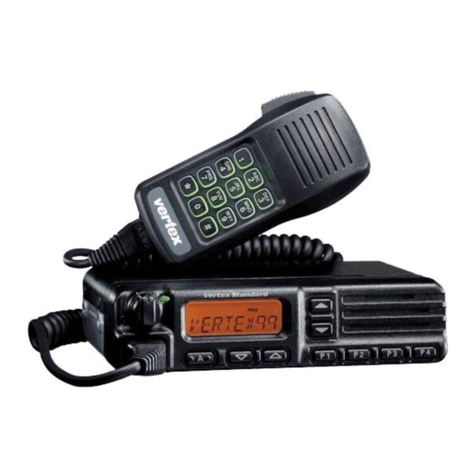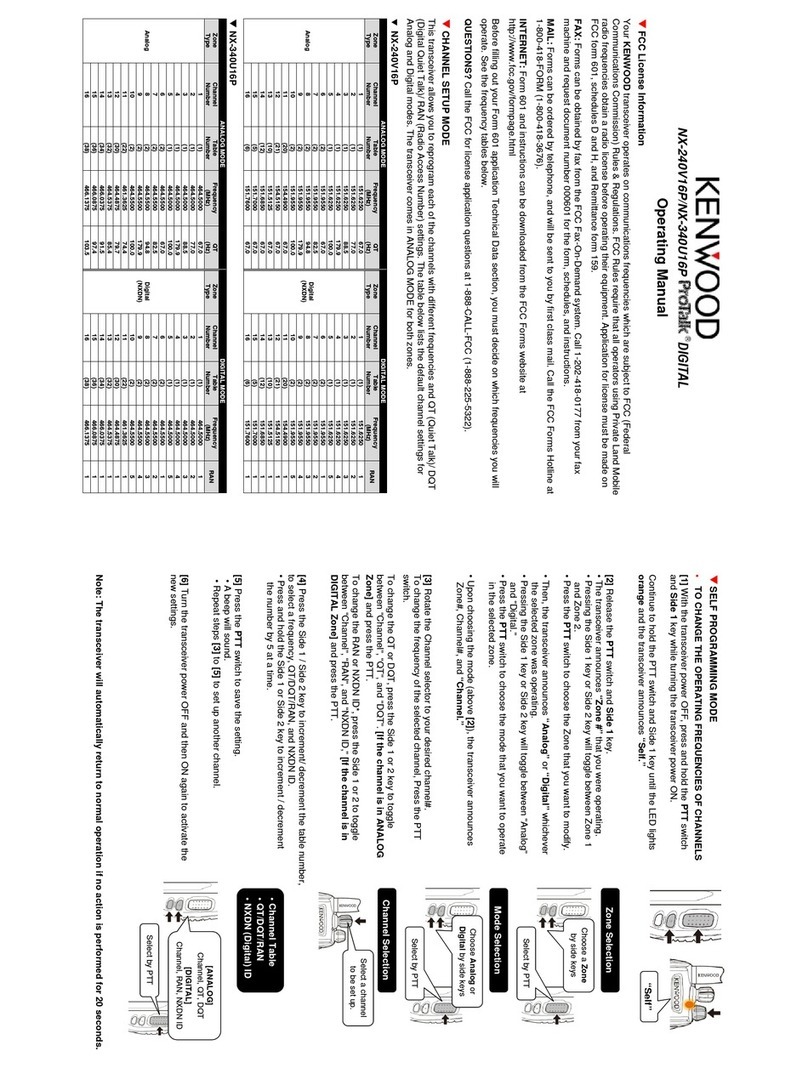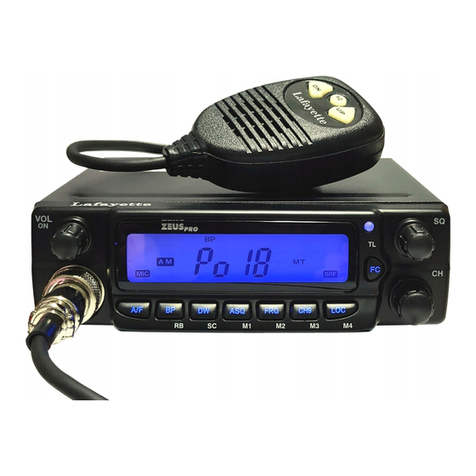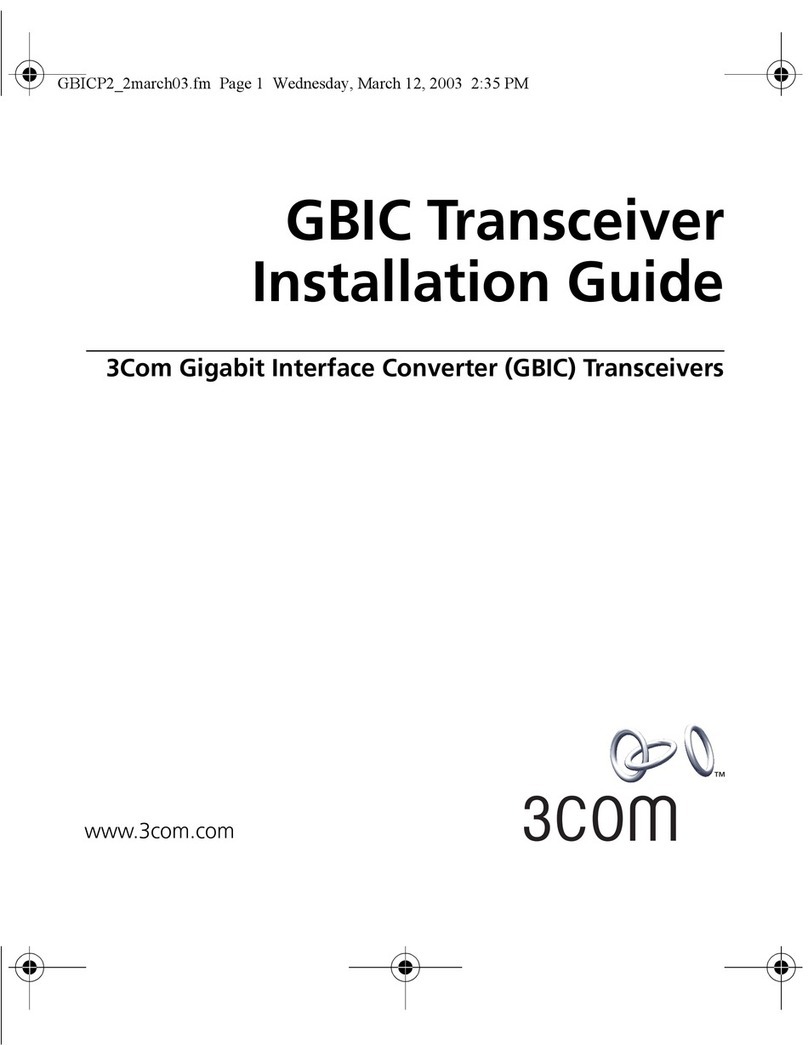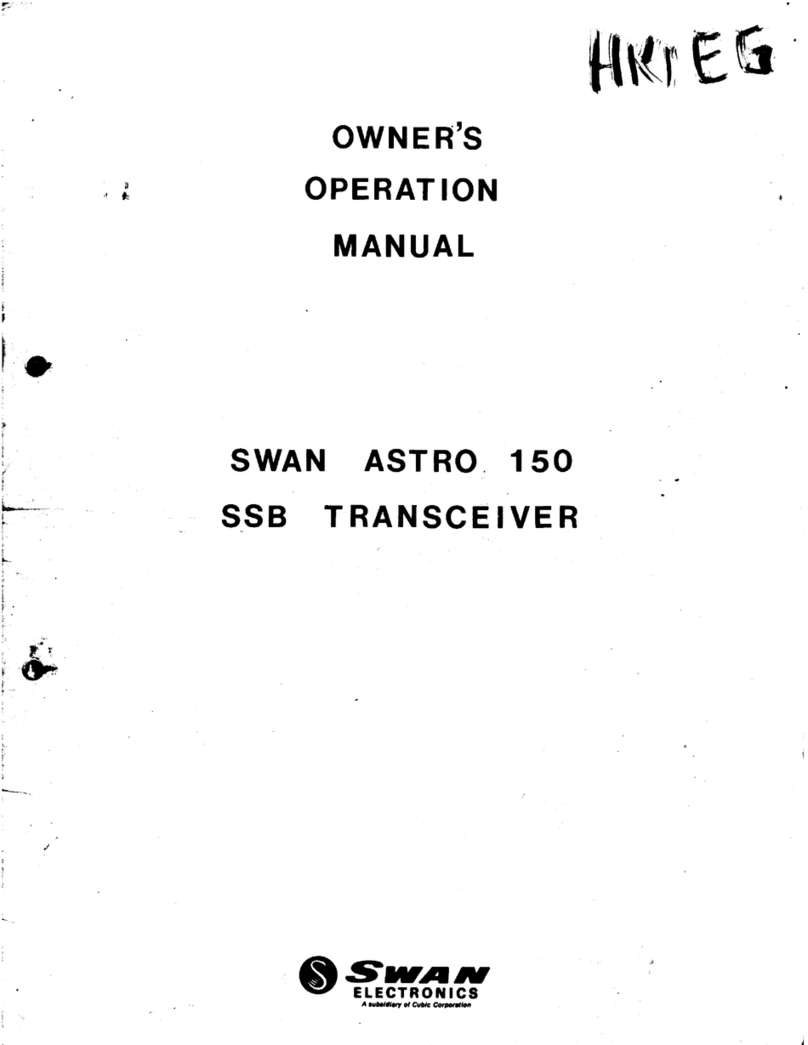Icom IC-E90 User manual

This device complies with Part 15 of the FCC Rules. Operation is sub-
ject to the following two conditions: (1) This device may not cause
harmful interference, and (2) this device must accept any interference
received, including interference that may cause undesired operation.
iE90
MULTIBAND FM TRANSCEIVER
INSTRUCTION MANUAL
WARNING: MODIFICATION OF THIS DEVICE TO RECEIVE CEL-
LULAR RADIO TELEPHONE SERVICE SIGNALS IS PROHIBITED
UNDER FCC RULES AND FEDERAL LAW.

i
Thank you for purchasing this Icom product. The IC-E90
MULTI BAND TRANSCEIVER is designed and built with
Icom’s superior technology and craftsmanship. With proper
care, this product should provide you with years of trouble-
free operation.
The IC-E90 is a tri-band, 50 MHz, 144 MHz, 430 MHz FM
transceiver that offers a wide-band AM, FM and WFM scan-
ning receiver*. Not only you can hear your favorite TV pro-
grams with the pre-programmed TV memories*, but you can
also listen to short wave, AM and FM broadcast radio
stations, aircraft, various amateur bands and more.
New DMS(Dynamic Memory Scan) bank scanning provides
555 alphanumeric memory channels, including 50 band
edges, with a maximum of 18 banks or 100 channels per
bank. You can pick and choose any desired channel for
scanning from the 500 memories.
The supplied BP-217
LITHIUM
-
ION BATTERY PACK
provides full
5 W of output. Along with the energy conserving settings, the
BP-217 provides up to 5 to 6 hours of operating time. The
newly designed antenna also provides stable signal strength.
We want to thank you for making your IC-E90 your radio of
choice, and hope you agree with Icom’s philosophy of “tech-
nology first.” Many hours of research and development went
into the design of your IC-E90.
ïï
FEATURES
❍
Tri-band FM transceiver
❍
Wide-band receiver
—Covers 495 KHz to 999.990* MHz
❍
New DMS (Dynamic Memory Scan)
bank scan
❍
Lithium-Ion technology
❍
Rugged palm sized, weather-resis-
tant construction
❍
DTCS and CTCSS tone squelch
❍
Simple operation
*Available frequency range and/or the pre-pro-
grammed TV memories may differ depends on ver-
sion. See p. 85 for details.
FOREWORD

ii
IMPORTANT
READ ALL INSTRUCTIONS carefully and completely
before using the transceiver.
SAVE THIS INSTRUCTION MANUAL —This in-
struction manual contains important operating instructions for
the IC-E90.
EXPLICIT DEFINITIONS
The explicit definitions below apply to this instruction manual.
WORD
WARNING
CAUTION
NOTE
DEFINITION
Personal injury, fire hazard or electric
shock may occur.
If disregarded, inconvenience only. No risk
of personal injury, fire or electric shock.
Equipment damage may occur.
Icom, Icom Inc. and the Icom logo are registered trademarks of Icom
Incorporated (Japan) in Japan, the United States, the United
Kingdom, Germany, France, Spain, Russia and/or other countries.
SUPPLIED ACCESSORIES
Accessories included with the transceiver: Qty.
qLi-Ion battery pack (BP-217) .......................................... 1
wWall charger* (BC-110D/DR) .......................................... 1
eMB-83 (Swivel belt clip) ........................................... 1 set
rHandstrap........................................................................ 1
tAntenna (FA-S6270D; with 50 MHz band adapter) .. 1 set
*Not supplied with some versions.
q
w
ert

iii
RRWARNING RF EXPOSURE! This device emits
Radio Frequency (RF) energy. Extreme caution should be
observed when operating this device. If you have any ques-
tions regarding RF exposure and safety standards please
refer to the Federal Communications Commission Office of
Engineering and Technology’s report on Evaluating
Compliance with FCC Guidelines for Human Radio
Frequency Electromagnetic Fields (OET Bulletin 65)
RRWARNING! NEVER hold the transceiver so that the
antenna is very close to, or touching exposed parts of the
body, especially the face or eyes, while transmitting. The
transceiver will perform best if the microphone is 1 to 2 in (2
to 5 cm) away from the lips and the transceiver is vertical.
RRWARNING! NEVER operate the transceiver with a
headset or other audio accessories at high volume levels.
Hearing experts advise against continuous high volume oper-
ation. If you experience a ringing in your ears, reduce the vol-
ume level or discontinue use.
RRDAMAGE WILL BE OCCUR IF THESE LIMITS
ARE EXCEEDED, when charging the IC-E90 with the
BP-217 battery pack from the external DC power jack on the
radio, the DC input voltage must between 10.5 to 11.5 V,
except when using optional CP-19R Cigarette Lighter cable.
NEVER connect the transceiver to an AC outlet . Such a
connection will damage the transceiver.
NEVER connect the transceiver to a power source that is
DC fused at more than 5 A. Accidental reverse connection will
be protected by this fuse, but higher fuse values will not give
protection against such accidents and the transceiver will be
ruined.
DO NOT operate the transceiver near unshielded electrical
blasting caps or in an explosive atmosphere.
AVOID using or placing the transceiver in direct sunlight or
in areas with temperatures below –10°C (+14°F) or above
+60°C (+140°F).
RF output power is automatically reduced to 0.5 W (Low) in
cold environments (below 0°C) while operating with the BP-217
Li-Ion battery pack, to protect the battery pack. Keep the bat-
tery pack warm, then select high power again. (p. 28)
The use of non-Icom battery packs/chargers may impair
transceiver performance and invalidate the warranty.
Even when the transceiver power is OFF, a slight current still
flows in the circuits. Remove the battery pack or case from
the transceiver when not using it for a long time. Otherwise,
the battery pack or installed batteries will become exhausted.
CAUTIONS

iv
FOREWORD ............................................. i
IMPORTANT ............................................. ii
EXPLICIT DEFINITIONS .......................... ii
SUPPLIED ACCESSORIES ..................... ii
CAUTIONS ............................................... iii
TABLE OF CONTENTS ........................... iv
qQUICK REFERENCE GUIDE ........ 1 – 6
wPANEL DESCRIPTION ................ 7 – 12
■Panel description ............................. 7
■Function display ............................. 11
eBATTERY CHARGING .............. 13 – 16
■Battery attachment ......................... 13
■Battery cautions ............................. 13
■Regular charging ........................... 14
■Rapid charging ............................... 15
■Battery case ................................... 16
■External power operation ............... 16
rBASIC OPERATION .................. 17 – 33
■Turning power ON ......................... 17
■Tuning step .................................... 18
■Setting a frequency ........................ 19
■Mode selection ............................... 20
■Operating band and receive mode
selection ......................................... 21
■Setting the squelch level ................ 22
■Receiving ....................................... 23
■RIT function ................................... 27
■Attenuator function ......................... 27
■Transmitting ................................... 28
■Repeater operation ........................ 29
■Duplex operation ............................ 31
■Split operation ................................ 32
■1750 Hz tone ................................. 33
tMEMORY/CALL CHANNELS .... 34 – 44
■General .......................................... 34
■Calling up memory channels ......... 36
■Programming memory channels .... 37
■Transferring memory contents
to VFO ........................................... 38
■Copying memory contents ............. 39
■Memory names .............................. 39
■Memory bank ................................. 41
■Memory clear ................................. 43
■Call channel ................................... 44
ySCAN OPERATION ................... 45 – 49
■Scan types ..................................... 45
■VFO scan ....................................... 46
■Frequency skip function ................. 47
■Skip channel setting ....................... 47
■Memory scan ................................. 48
■Scan notes ..................................... 49
uPRIORITY WATCH .................... 50 – 54
■Priority watch types ........................ 50
■Priority alert .................................... 50
■Priority watch operation ................. 51
iSET MODE ................................ 55 – 66
■Set mode ....................................... 55
■Set mode items ............................. 56
oOTHER FUNCTIONS ................ 67 – 78
■Programming a DTMF code .......... 67
■Transmitting a DTMF code ............ 68
■Clearing a DTMF memory ............. 69
■Confirming a DTMF memory ......... 69
■Tone frequency and DTCS code .... 70
■Tone/DTCS squelch ....................... 71
■Pocket beep function ...................... 71
■Available tone frequencies ............. 72
■Available DTCS codes ................... 72
■Tone scan ...................................... 73
■Beep tones ..................................... 74
■Dial speed acceleration ................. 74
■Lock function .................................. 74
■Morse code synthesizer ................. 75
■Power save .................................... 75
■Time-out timer ................................ 76
■PTT lock ......................................... 76
■Auto power OFF ............................ 76
■Auto power ON .............................. 76
■Cloning function ............................. 77
■[SP/MIC] jacks ............................... 77
■Resetting ........................................ 78
!0 HM-75A REMOTE CONTROL
MICROPHONE ................................. 79
!1 TROUBLESHOOTING ..................... 80
!2 TV FREQUENCY TABLE ........... 81 – 84
!3 SPECIFICATIONS ..................... 85 – 86
!4 OPTIONS ................................... 87 – 88
POCKET GUIDE
DOC
TABLE OF CONTENTS
qq
ww
ee
rr
tt
yy
uu
ii
oo
!!00
!!11
!!22
!!33
!!44

1
QUICK REFERENCE GUIDE
1
■Installing the battery pack
qOpen the latch. Then, attach the BP-217 Li-Ion battery
pack or optional BP-216 battery case.
•Be sure to observe the correct direction.
•Charge Li-Ion battery pack before use.
wLock the latch.
NOTE: The battery pack is provided uncharged. BE SURE to
charge the battery before using it with the transceiver.
DInstalling the alkaline batteries
Install 2 R6 (AA) size alkaline batteries into BP-216.
•Be sure to observe the correct po-
larity.
Keep battery contacts clean. It’s
a good idea to clean battery ter-
minals once a week.
■Accessory attachment
DAttaching the swivel belt clip
The supplied swivel belt clip is useful for easy attaching/
detaching the transceiver to/from the belt.
qAttach the stopper to
the transceiver with
the supplied screw.
wClip the belt clip to
your belt.
Battery pack or
battery case
Latch
q
w
stopper
supplied
screw

2
1
QUICK REFERENCE GUIDE
eInsert the transceiver to the end of the
clip as shown at right.
•Once the transceiver
is locked in place, it
will swivel 360
degrees as shown at
right.
To remove:
rTurn the transceiver upside down, and then lift to release
the transceiver from the belt clip as shown at upper right.
DHandstrap
Slide the handstrap through the loop on
the top of the belt clip as shown at
right.
QUICK REFERENCE GUIDE
qq
iC-t90
a
CAUTION!
HOLD THE TRANSCEIVER TIGHTLY, WHEN ATTACHING
OR REMOVING THE TRANSCEIVER TO/FROM THE
BELT CLIP.
If the transceiver accidentally dropped and the swivel belt
clip’s stopper is scratched, the swivel belt clip may not work
properly.

3
1QUICK REFERENCE GUIDE
50 MHz band
adapter
Attach the 50 MHz
band adapter
Hold the base , then screw the
antenna down.
for BC
band to 50 MHz band,
through to 800 MHz band
for WFM band
to
800 MHz band
Detach the top cap*
*KEEP the the anttenna top cap
in the safe place when it not
in use.
DInstalling the antenna
Insert the supplied wide band antenna into the antenna con-
nector and screw down the antenna as shown below.
•50 MHz band adapter
Attach the 50 MHz band antenna adapter before operating
50 M Hz band or receiving the signal below 50 MHz band. Be
sure to use this 50 MHz band adapter during the operation
below 50 MHz band. You can operate the whole band with
this adapter.
CAUTION!
TRANSMITTING WITHOUT AN ANTENNA MAY DAMAGE
THE TRANSCEIVER.
NEVER HOLD the anten-
na when carrying the trans-
ceiver.
KEEP the jack covers at-
tached when the jack is not
in use, to avoid bad con-
tacts from dust and mois-
ture.
NOTE:
Commercially available antennas may increase transceiver
performance. An optional AD-92SMA ANTENNA CONNECTOR
ADAPTER is available to connect an external antenna with a
BNC connector.

4
1
QUICK REFERENCE GUIDE
■Charging the Li-Ion battery pack
DCharging with the wall charger
qPush and hold [PWR] to turn the transceiver power OFF.
wInsert the charger plug into the DC power jack of the trans-
ceiver.
ePlug the charger into an AC wall outlet.
rCharging starts and the battery indicator “ ” on the dis-
play blinks.
tIt takes approximately 15 hours to charge an empty BP-
217 Li-Ion battery pack.
yUnplug the charger from the AC wall outlet when charging
is completed.
DCharging with the CP-19R Cigarette Lighter
cable (option)
qInsert the cigarette lighter adapter cable into the DC power
jack of the transceiver.
wConnect the CP-19R cigarette lighter adapter cable to the
cigarette lighter socket.
eCharging starts and the battery indicator on the display
blinks.
NOTE:
•The BP-217 can be charged while you operating the transceiver.
(p. 5).
•Charging will be suspended during transmitting of the transceiver.
•“CHG_F” appears when the charging is completed with the power
turned OFF.
•NEVER connect the cigarette lighter socket or external regulated
DC power supply directly to the transceiver. Such a connection will
damage the transceiver.
•Remove CP-19R from the transceiver when not using it. Otherwise,
the vehicle battery will become exhausted.
IC-E90 with BP-217
BC-110D/DR
to
DC power jack
to AC outlet
CP-19R
(optional)
to
DC power
jack
to a 12 V
cigarette lighter
socket
QUICK REFERENCE GUIDE
qq

5
1QUICK REFERENCE GUIDE
■Rapid charging
The optional BC-139 provides rapid charging of the battery
pack.
CAUTION: To avoid damage to the transceiver, turn the
transceiver OFF while charging.
•Charging period: 2.5 hours (w/BP-217)
■External power operation
An optional CP-19R cigarette lighter cable can be used for
external power operation from cigarette lighter socket.
•External power supply range is between 5.5–11.0 V DC.
NEVER connect over 11.5 V DC directly into the DC
power jack of the transceiver. DAMAGE WILL OCCUR
IF THESE LIMITS ARE EXCEEDED.
•BE SURE to use the CP-19R when connecting a regu-
lated 12 V DC power supply.
•The maximum output power is 5.0 W regardless of the
power supply voltage.
•Remove the cables from the transceiver when not using
it. Otherwise, the vehicle battery will become exhausted
CP-19R
(optional)
to
DC power
jack
to a 12 V
cigarette lighter
socket
Tu r n power
OFF.
Check the
orientation.
BP-217
Li-Ion battery pack
to AC
outlet
BC-139 (optional)
desktop charger
BC-123E
(supplied with
BC-139)
to [AC ADAPTER] jack
A
Adapter (supplied
with BC-139)
LED
Charging:
Orange
Finished:
Green
Charging
terminal

6
1
QUICK REFERENCE GUIDE
■Your first contact
Now that you have your IC-E90 ready to operate, you are
probably excited to get on the air. We would like to take you
through a few basic operation steps to make your first “On
The Air” an enjoyable experience.
DFirst contact
qPush and hold [PWR] for 1 sec. to turn the transceiver
power ON.
•The function display shows “ICOM,” current voltage then the op-
erating frequency.
wPush [BAND] several times until the desired operating
band (VHF; 51.000, 145.000 or UHF; 430.000 as default)
appears on the display.
ePush [Y](or [Z]) several times to adjust to the desired
audio level.
rRotate [DIAL] to select the receive frequency.
‘Direct frequency input’ via the keypad also available.
(p. 19)
tHold the transceiver approximately 5 cm. (2 in) from your
mouth.
yPush and hold [PTT], then speak at your normal voice
level.
uRelease [PTT] switch to receive.
•Repeat steps, t, yand uto continue communication.
r
e
q
w
yu
[DIAL]
[PTT]
[UP/DOWN]
[BAND]
[PWR]
[Mic]
QUICK REFERENCE GUIDE
[EXAMPLE] Setting the
receive frequency to
439.350 MHz
qq

■Panel description qPOWER SWITCH [PWR]
Push for 1 sec. to turn the transceiver power ON and OFF.
wBAND SWITCH [BAND]
➥Push to select the operating band (50MHz, Air, VHF,
UHF, etc.). (p. 21)
➥Push to select the memory bank or push to proceed the
memory name cursor while programming the memory
option. (pgs. 39, 41)
➥Push for 1 sec. for morse code synthesizer announce-
ment. (p. 75)
➥While pushing [PTT], this key sends a DTMF “D”.
eUP/DOWN SWITCHES [Y]/[Z]
➥Push to adjust the audio level by default. (p. 17)
➥Push to adjust the frequency when [Y]/[Z] and [DIAL]
are exchanged by pushing [1 V↔D] for 1 sec. (p. 23)
rMONITOR SWITCH [SQL] (p. 22)
➥Push and hold to temporarily open the squelch and
monitor the operating frequency.
➥While pushing, rotate the tuning dial to set the squelch
threshold level.
tTRANSMIT/RECEIVE INDICATOR
➥Lights green while receiving a signal or when the
squelch is open; lights red while transmitting.
➥Flashes green for 5 sec. when the scan stop LED func-
tion is in use and a scan is stopped. (pgs. 49, 62)
t
u
i
o
!0
!1
!2
!3
!4
Keypad !6–@5
!5
e
r
q
w
y
Function display
Speaker
Microphone
7
2PANEL DESCRIPTION

8
2
PANEL DESCRIPTION
yPTT SWITCH [PTT]
➥Push and hold to transmit in 50/144/430 MHz amateur
bands; release to receive. (p. 28)
•When WFM or AM mode is selected, transmission is impossible.
uANTENNA CONNECTOR (p. 3)
Connects the supplied antenna.
iEXTERNAL SPEAKER AND MICROPHONE JACKS
[SP/MIC]
Connects an optional speaker-microphone or headset, if
desired. The internal microphone and speaker will not
function when any external equipment is connected. (See
pgs. 87, 88 for a list of available options.)
oTUNING DIAL [DIAL]
➥Rotate [DIAL] to set operating frequencies, memory
channels, set mode contents, etc. (pgs. 19, 36, 55)
➥While pushing [SQL], sets the squelch level. (p. 22)
➥While pushing [BAND], sets the operating band in VFO
mode. (p. 21)
➥While pushing [Y]/[Z], adjusts the audio level (when
[Y]/[Z] and [DIAL] are not exchanged). (p. 17)
!0 EXTERNAL DC POWER JACK [DC 11.0 V]
➥Allows charging of the BP-217 using the BC-110D/DR
wall charger, or using an optional CP-19R cigarette
lighter cable.
➥To connect regulated power supply with optional
CP-19R cigarette lighter cable.
!1 MODE/SCAN SWITCH [MODE SCAN]
➥Push to select the operating mode (FM, WFM,
AM). (p. 21)
➥Push for 1 sec. to start a scan. (p. 46)
➥While pushing [PTT], this key sends the DTMF code “F”
(#).
!2 VFO SWITCH [VFO MHz]
➥Selects and toggles between VFO A and B.
(p. 20)
➥Selects and toggles between the 1 MHz or 10
MHz tuning steps when pushed for 1 sec.
(p. 18)
➥Returns to previous operating condition while setting fre-
quency or memory channel, or while in set mode.
➥While pushing [PTT], this key sends the DTMF code “A”.
!3 MEMORY SWITCH [MR S.MW]
➥Selects and toggles between memory mode
and memory bank. (p. 20)
➥Push [MR S.MW] for 1 sec. to enter memory
write condition. (p. 37)
➥Push for 2 sec. to write the operating frequency into the
selected memory channel in VFO mode.
•Keep pushing for 2 sec. or more to automatically select the
next memory channel, if desired. (p. 38)
➥Push for 2 sec. to transfer the displayed frequency into
the VFO in memory mode. (p. 38)
➥While pushing [PTT], this key sends the DTMF code “B”.
MR
S.MW
B
VFO
MHz
A
MODE
SCAN
ww
PANEL DESCRIPTION

9
2PANEL DESCRIPTION
!4 CALL/LOCK SWITCH [CALL/TV LOCK]
➥Toggles between call channel, TV channel*,
and VFO mode in sequence. (p. 20)
*Depends on version.
➥Push for 1 sec. to toggle the lock function ON and OFF.
(p. 74)
•“
é
” appears while the key lock function is in use.
➥While pushing [PTT], this key sends the DTMF code “C”.
!5 DTMF MEMORY SWITCH [• DTMF.M]
➥Push for 1 sec. to enter the DTMF memory
channel. (p. 67)
➥Inputs MHz digit for frequency input. (p. 19)
➥While pushing [PTT], this key sends the DTMF code “E”
(M).
!6 VOLUME/DIAL SWITCH [1 V↔D]
➥Push for 1 sec. to exchange [Y]/[Z] and
[DIAL] functions. (p. 23)
•“VOL” appears when the tuning dial functions as a
volume control.
➥Inputs digit ‘1’ for frequency input, memory channel se-
lection, etc.
➥While pushing [PTT], this key sends the DTMF code “1”.
!7 TONE SWITCH [2 TONE] (p. 70)
➥Push for 1 sec. to activate the following tone
functions in order.
•Subaudible tone encoder — “T” appears. (p. 29)
•Tone squelch — “T SQL” appears. (p. 71)
•Pocket beep — “T SQLS” appears. (p. 71)
•DTCS squelch — “DTCS” appears. (p. 71)
•DTCS beep — “SDTCS” appears. (p. 71)
•No tone operation — no tone indicator appears.
➥Inputs digit ‘2’ for frequency input, memory channel se-
lection, etc.
➥While pushing [PTT], this key sends the DTMF code “2”.
!8 OUTPUT POWER SWITCH [3 H/L] (p. 28)
➥Push for 1 sec. to toggle the output power be-
tween high and low.
•“LOW” appears when low output power is selected.
➥Inputs digit ‘3’ for frequency input, memory channel se-
lection, etc.
➥While pushing [PTT], this key sends the DTMF code “3”.
!9 DUPLEX SWITCH [4 DUP] (pgs. 29, 31)
➥Push for 1 sec. to activate the following duplex
functions in order.
•Minus duplex operation — “–DUP” appears.
•Plus duplex operation — “DUP” appears.
•Simplex operation — no duplex indicator appears.
➥Inputs digit ‘4’ for frequency input, memory channel se-
lection, etc.
➥While pushing [PTT], this key sends the DTMF code “4”.
4
DUP
3
H/L
2
TONE
1
V D
.
DTMF.M
CALL/TV
LOCK
C

10
2
PANEL DESCRIPTION
@0 FREQUENCY SKIP SWITCH [5 SKIP]
➥Push for 1 sec. to turn the frequency skip func-
tion ON and OFF in VFO mode. (p. 47)
•“P SKIP” appears when the frequency skip function
is in use.
➥Push for 1 sec. to set the memory channel as the fol-
lowing skip channel in memory mode in order. (p. 48)
•Skip channel — “SKIP” appears.
•Frequency skip channel — “P SKIP” appears.
•Non-skip channel — no skip indicator appears.
➥Push for 1 sec. to program a paused frequency as a
skip frequency while scanning. (p. 46)
➥Inputs digit ‘5’ for frequency input, memory channel se-
lection, etc.
➥While pushing [PTT], this key sends the DTMF code “5”.
@1 MEMORY NAME SWITCH [6 M.N]
➥Push for 1 sec. to turn the memory name indi-
cation ON and OFF. (p. 40)
•Frequency appears for nameless memory chan-
nels.
➥Inputs digit ‘6’ for frequency input, memory channel se-
lection, etc.
➥While pushing [PTT], this key sends the DTMF code “6”.
@2 TONE SCAN SWITCH [7 T.SCAN]
➥Push for 1 sec. to start a tone scan. (p. 73)
➥Inputs digit ‘7’ for frequency input, memory
channel selection, etc.
➥While pushing [PTT], this key sends the DTMF code “7”.
@3 SET MODE SWITCH [8 SET]
➥Push for 1 sec. to enter the set mode. Push to
select the displayed set mode item after se-
lecting with [DIAL] while in the set mode.
(p. 55)
➥Inputs digit ‘8’ for frequency input, memory channel se-
lection, etc.
➥While pushing [PTT], this key sends the DTMF code “8”.
@4 TUNING STEP SWITCH [9 TS]
➥Push for 1 sec. to select the tuning step.
(p. 18)
➥Inputs digit ‘9’ for frequency input, memory
channel selection, etc.
➥While pushing [PTT], this key sends the DTMF code “9”.
@5 RIT/ATTENUATOR SWITCH [0 RIT]
➥Push for 1 sec. to enter the RIT/attenuator set
mode. Push to select the item after selecting
with [DIAL]. (p. 27)
•RIT function is available for 630.000 MHz and above.
•Attenuator for 629.995 MHz or less only.
➥Inputs digit ‘0’ for frequency input, memory channel se-
lection, etc.
➥While pushing [PTT], this key sends the DTMF code “0”.
0
RIT
9
TS
8
SET
7
T.SCAN
6
M.N
5
SKIP
ww
PANEL DESCRIPTION

11
2PANEL DESCRIPTION
■Function display
qFREQUENCY READOUT
Shows the operating frequency, set mode contents, etc.
•The smaller “75,” “50” and “25” to the right of the readout indi-
cate 0.75, 0.5 and 0.25 kHz, respectively.
•The decimal point of the frequency flashes during scan.
wLOCK INDICATOR (p. 74)
Indicates that the lock function is in use.
eRECEIVE MODE INDICATORS (p. 21)
Shows the receive mode.
•AM, FM and WFM are available.
rDUPLEX INDICATORS (pgs. 29, 31)
Appears when semi-duplex operation (repeater operation)
is in use.
•“–DUP” appears when minus duplex is selected; “DUP” only, ap-
pears when plus duplex is selected.
q
we r t yu
i
o
!0
!1!2!5 !3!4

12
2
PANEL DESCRIPTION
tTONE INDICATORS (p. 70)
➥Appear when the following tone functions are activated.
•Subaudible tone encoder — “T” appears. (p. 29)
•Tone squelch — “T SQL” appears. (p. 71)
•Pocket beep — “T SQLS” appears. (p. 71)
•DTCS squelch — “DTCS” appears. (p. 71)
•DTCS beep — “SDTCS” appears. (p. 71)
➥“S” flashes when the correct tone or code is received
during pocket/DTCS beep operation. (p. 71)
yRIT INDICATOR (p. 27)
Appears when the RIT (Receive Incremental Tuning) func-
tion for 630.000 MHz and above is in use.
uSKIP SCAN INDICATOR (p. 47)
➥“SKIP” appears when a selected memory channel is set
as a skip channel.
➥“P SKIP” appears when the memory channel frequency
is set as a skip frequency in memory mode.
➥“P SKIP” appears when the frequency skip function is
turned ON in VFO mode.
iPRIORITY WATCH INDICATOR (p. 50)
Appears when priority watch is in use.
oMEMORY MODE INDICATOR (p. 20)
Appears when a memory channel is selected.
!0 MEMORY CHANNEL READOUT (p. 20)
Shows the memory or call channel number, etc.
!1 S/RF INDICATORS (p. 28)
Shows the relative signal strength while receiving. Shows
the relative output power while transmitting.
!2 LOW POWER INDICATOR (p. 28)
Appears when low output power is selected.
!3 VOLUME EXCHANGE INDICATOR (p. 23)
Appears when the functions of tuning dial and [Y]/[Z]
switches are exchanged.
!4 BATTERY INDICATORS
➥Both segments appear when the batteries have ample
capacity.
•They do not appear when operating with an external power
source.
➥Only the right segment “ ” appears when the batteries
are nearing exhaustion.
➥Blinks while charging the attached Li-Ion battery pack.
!5 ATTENUATOR INDICATOR (p. 27)
Appears when the attenuator is in use.
ww
PANEL DESCRIPTION

■Battery attachment
qAttach the BP-217 Li-Ion battery pack or optional BP-216
battery case.
•Be sure to observe the correct direction.
•Charge Li-Ion battery pack before use.
wLock the latch.
DOperating periods
The operating periods with BP-217 are:
50 MHz Approx. 6 hr.
144 MHz Approx. 5 hr.
440 MHz Approx. 5 hr.
at high power, Tx : Rx : Standby = 1:1:8
■Battery cautions
NEVER incinerate used battery packs. Internal battery gas
may cause an explosion.
NEVER immerse the battery pack in water. If the battery pack
becomes wet, be sure to wipe it dry BEFORE attaching it to
the transceiver.
NEVER short terminals of the battery pack. Also, current may
flow into nearby metal objects so be careful when placing bat-
tery packs in handbags, etc.
If your battery pack seems to have no capacity even after
being charged, completely discharge it by leaving the power
ON overnight. Then, fully charge the battery pack again. If the
battery pack still does not retain a charge (or very little), a
new battery pack must be purchased.
Use Icom battery packs, chargers and cables only. The use of
non-Icom products may impair transceiver performance and
invalidate the warranty.
Even when the transceiver power is OFF, a slight current still
flows in the circuits. Remove the battery pack or case from
the transceiver when not using it for a long time. Otherwise,
the battery pack or installed batteries will become exhausted.
Battery pack or
battery case
Latch
q
w
3BATTERY CHARGING
13

14
3
BATTERY CHARGING
■Regular charging
Prior to using the transceiver for the first time, the battery
pack must be fully charged for optimum life and operation.
CAUTION: To avoid damage to the transceiver, turn the
transceiver OFF while charging.
•Recommended temperature range for charging:
0°C to +35°C; +32°F to +95°F
•Use the wall charger* (BC-110AR/DR) only. NEVER use an-
other manufactures’ charger.
*Not supplied with some versions.
•An optional cable CP-19R (for 12 V cigarette lighter socket)
can be used instead of the AC adapters of the above charg-
ers.
DBattery indicators
The battery indicators blink while charging but do not indicate
the power condition.
“CHG_F” appears when the charging is completed. Discon-
nect the wall charger in this case.
qAttach the battery pack to the transceiver.
wBe sure to turn the transceiver power OFF.
eConnect the AC adapter* (BC-110D/DR) as shown below.
*Not supplied with some versions.
rRemove any cables from the [DC11V] jack.
•Charging period: 15 hours (w/BP-217)
ee
BATTERY CHARGING
IC-E90 with BP-217 BC-110D/DR
to AC outlet
to DC power
jack
to a 12 V
cigarette lighter
socket
CP-19R
(optional)

15
3BATTERY CHARGING
■Rapid charging
The optional BC-139 provides rapid charging of the battery
pack.
•Charging period: 2.5 hours (w/BP-217)
CAUTION: To avoid damage to the transceiver, turn it OFF
while charging.
•Recommended temperature range for charging:
0°C to +35°C; +32°F to +95°F
•NEVER connect 2 chargers to the [AC ADAPTER] and
[DC13.5V] jacks of BC-139.
•Use the supplied BC-123E for the BC-139 desktop charger.
Connect BC-123E to the [AC ADAPTER] jack.
•NEVER use another manufactures’ charger.
•An optional cable CP-19R (for 12 V cigarette lighter socket)
can be used instead of the supplied AC adapter. Connect
one of these to the [DC11V] jack in this case.
If the charge indicator blinks orange, there may be a prob-
lem with the battery pack (or charger). Re-insert the bat-
tery pack or contact your dealer.
Tu r n power
OFF.
Check the
orientation.
BP-217
Li-Ion battery pack
to AC
outlet
BC-139 (optional)
desktop charger
BC-123E
(supplied with
BC-139)
to [AC ADAPTER] jack
A
Adapter (supplied
with BC-139)
LED
Charging:
Orange
Finished:
Green
Charging
terminal
Other manuals for IC-E90
2
Table of contents
Other Icom Transceiver manuals
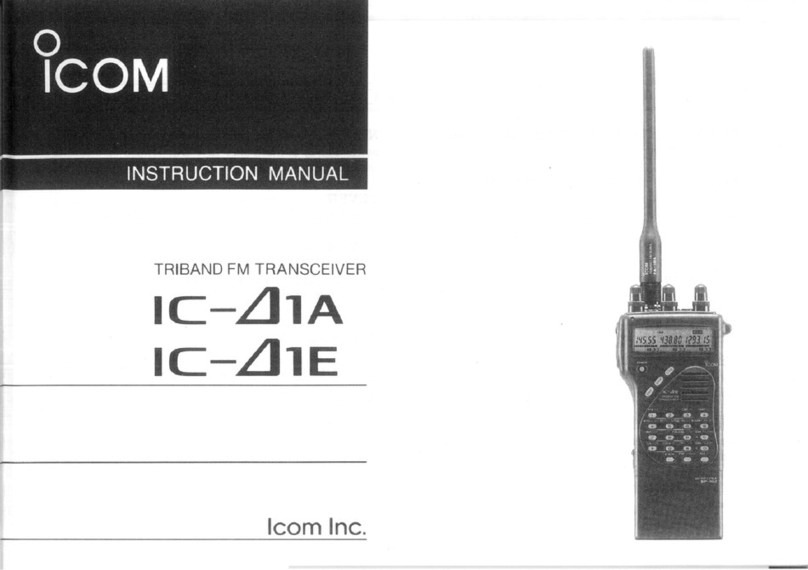
Icom
Icom IC-Delta1A User manual

Icom
Icom IC-M91D Installation and operating instructions
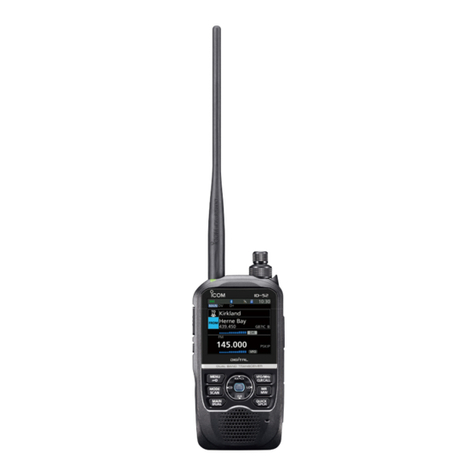
Icom
Icom ID-52A User manual
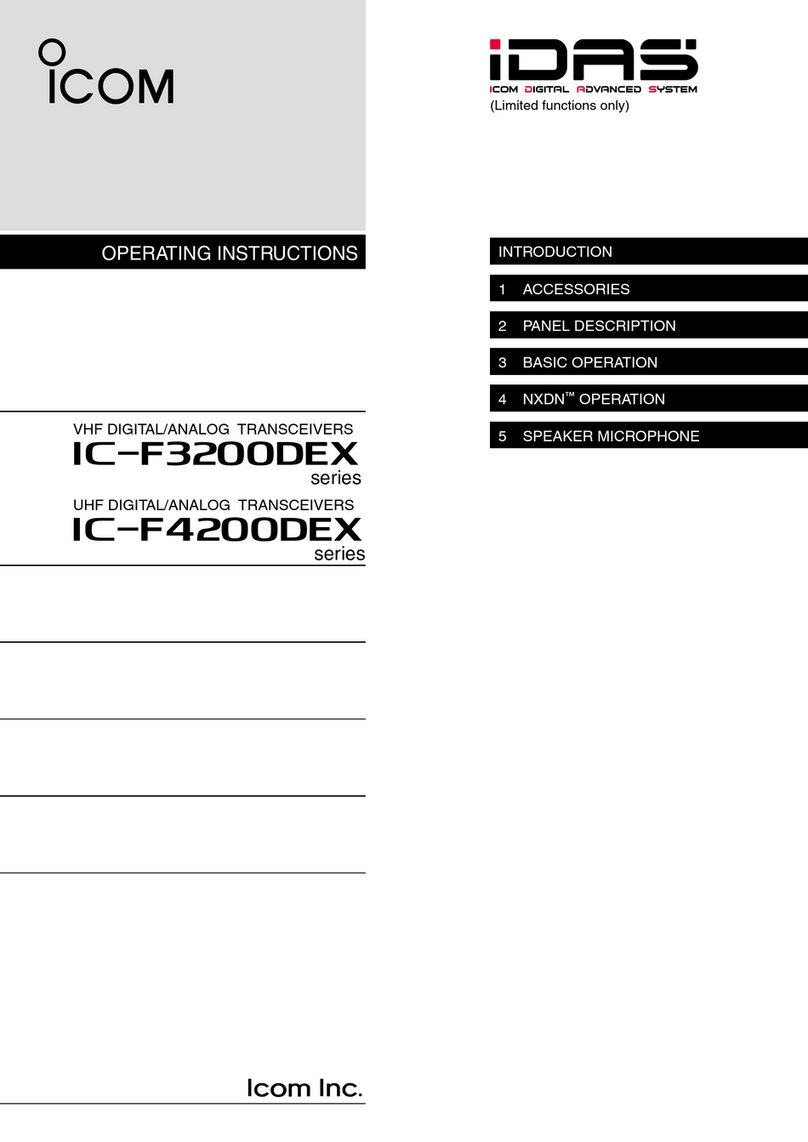
Icom
Icom iF3200DEX series User manual
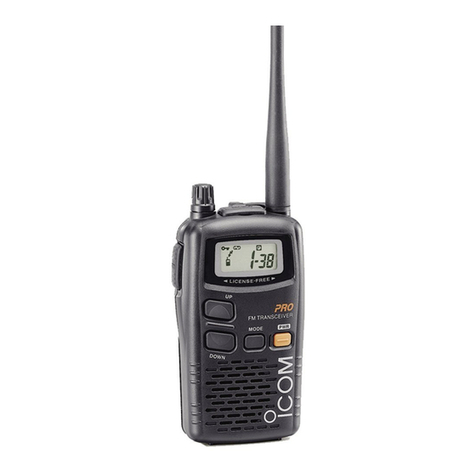
Icom
Icom IC-4088A Guide

Icom
Icom IC-F1710 User manual
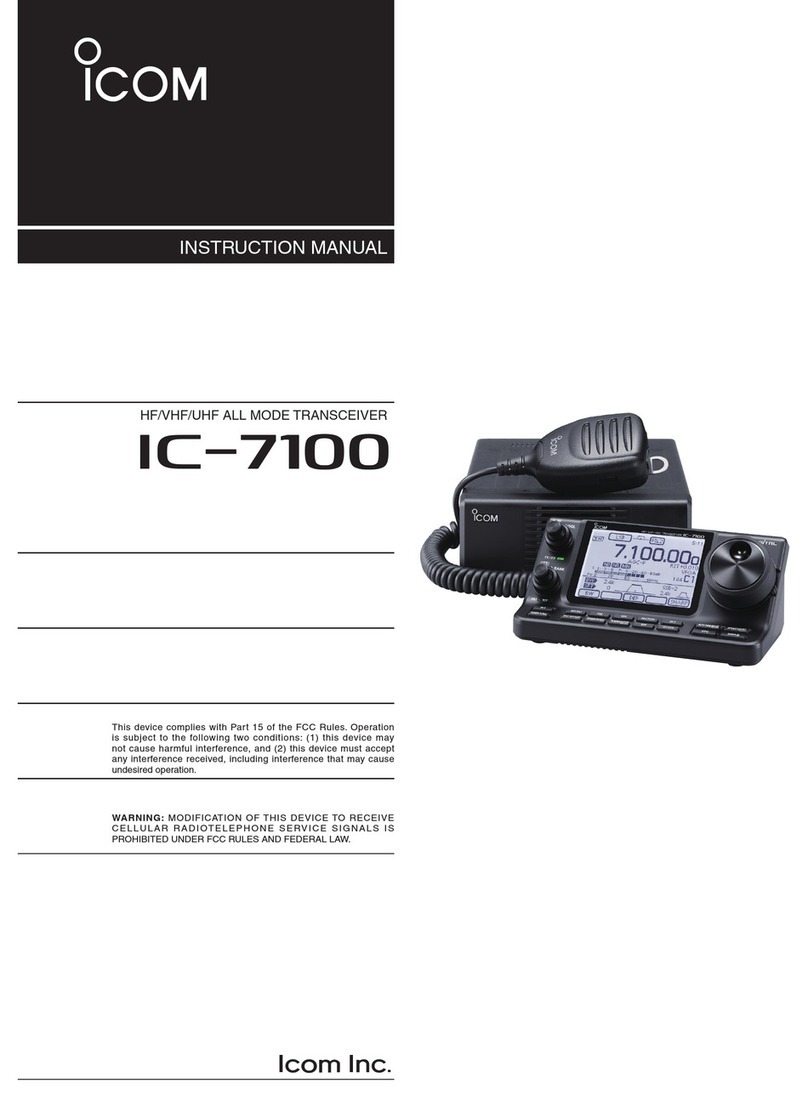
Icom
Icom IC-7100 User manual
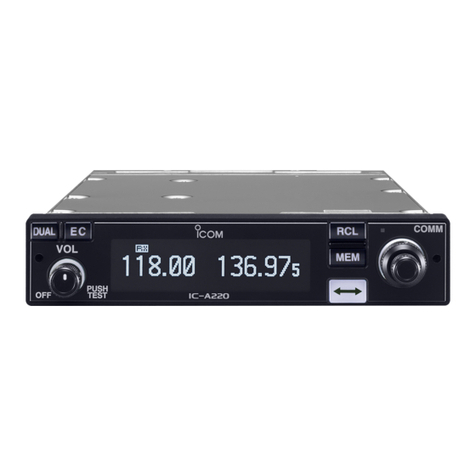
Icom
Icom IC-A220 User manual
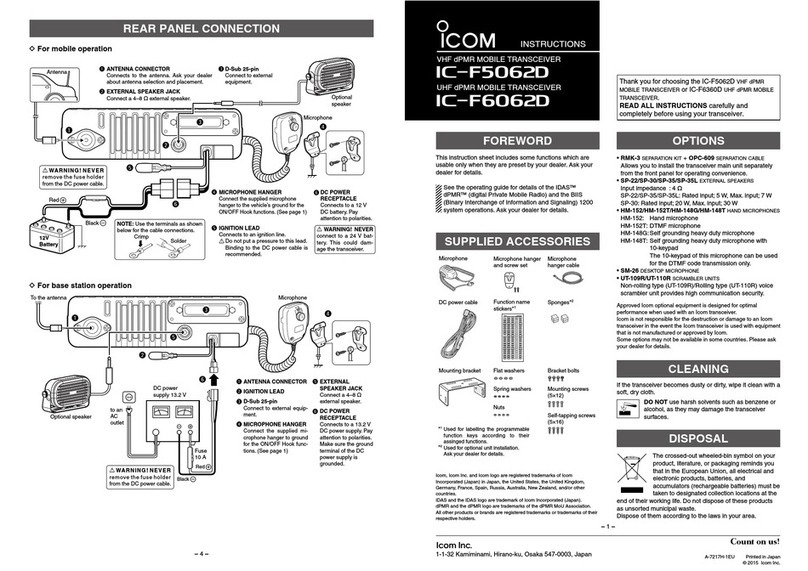
Icom
Icom IC-F5062D User manual
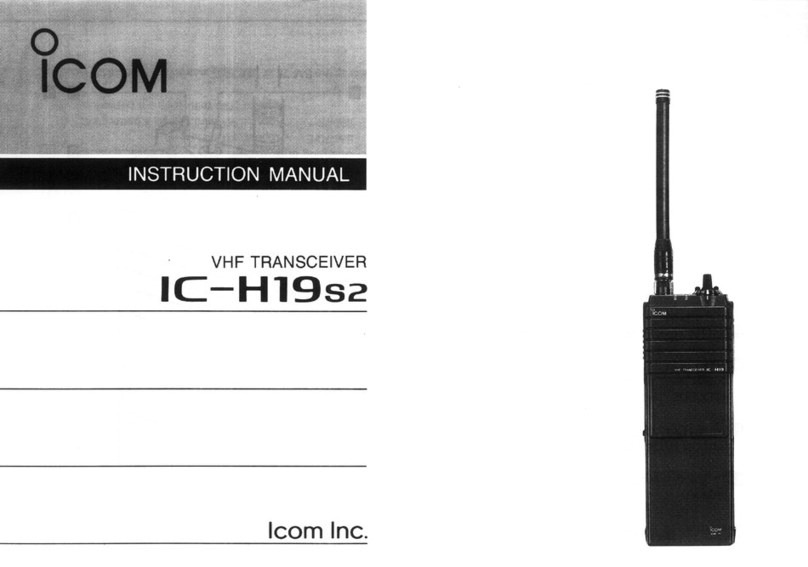
Icom
Icom IC-H19S2 User manual
